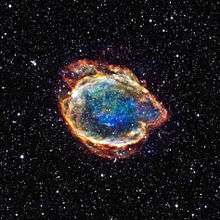SN 2213-1745
SN 2213-1745 was an extremely remote superluminous supernova (SLSN), which occurred in between November 2004 and June 2005. Its peak far-ultraviolet absolute magnitude reached −21.2, which was comparable to the total absolute magnitude of its host galaxy. The distance (redshift) to this supernova z=2.0458 ± 0.0005 makes it one of the most remote supernova observed as of 2012. The luminosity of SN 2213-1745 evolved slowly over several years as it was still detectable in November 2006. Both the high luminosity and slow decay indicate that the supernova's progenitor was a star with an initial mass as high as 250 solar masses. The supernova explosion itself was likely a pair-instability supernova similar to the SN 2007bi event, with which it shares many similarities.[1]
| Event type | Supernova |
|---|---|
| Spectral class | SLNS-R |
| Date | Supernova Legacy Survey |
| Constellation | Aquarius |
| Right ascension | 22h 13m 39.97s |
| Declination | −17° 45' 24.49 |
| Epoch | J2000.0 |
| Distance | z=2.0458 ± 0.0005 |
| Redshift | 2.0458 ±0.0005 |
| Progenitor | ~ 250 M☉ star |
References
- Cooke, J.; Sullivan, M.; Gal-Yam, A.; Barton, E. J.; Carlberg, R. G.; Ryan-Weber, E. V.; Horst, C.; Omori, Y.; Díaz, C. G. (2012). "Superluminous supernovae at redshifts of 2.05 and 3.90". Nature. 491 (7423): 228–231. arXiv:1211.2003. Bibcode:2012Natur.491..228C. doi:10.1038/nature11521. PMID 23123848.
External links
- Light curves and spectra on the Open Supernova Catalog
- 12 Billion-Year Old Supernova Discovered by Astronomers
- Elemental origins glimpsed in 12 billion year old supernova

